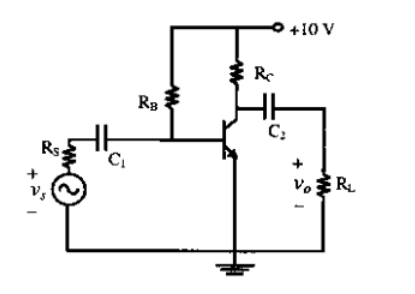Consider the common emitter amplifier shown below with the following circuit parameters: $\beta=100, g_{m}=0.3861 \mathrm{~A / V}, \mathrm{r}_{\mathrm{o}}=\infty, \mathrm{r}_{\mathrm{x}}=259 \; \Omega, \mathrm{R}_{\mathrm{s}}=1 \; \mathrm{k} \Omega, \mathrm{R}_{\mathrm{B}}=93 \; \mathrm{k} \Omega, \mathrm{R}_{\mathrm{C}}=250 \; \Omega, \mathrm{R}_{\mathrm{L}}=1 \; \mathrm{k} \Omega, \mathrm{C}_{1}=\infty$ and $\mathrm{C}_{2}=4.7 \;\mu \mathrm{F}.$

The resistance seen by the source $\nu_{s}$ is
- $258 \; \Omega$
- $1258 \; \Omega$
- $93 \; \mathrm{k} \Omega$
- $\infty$